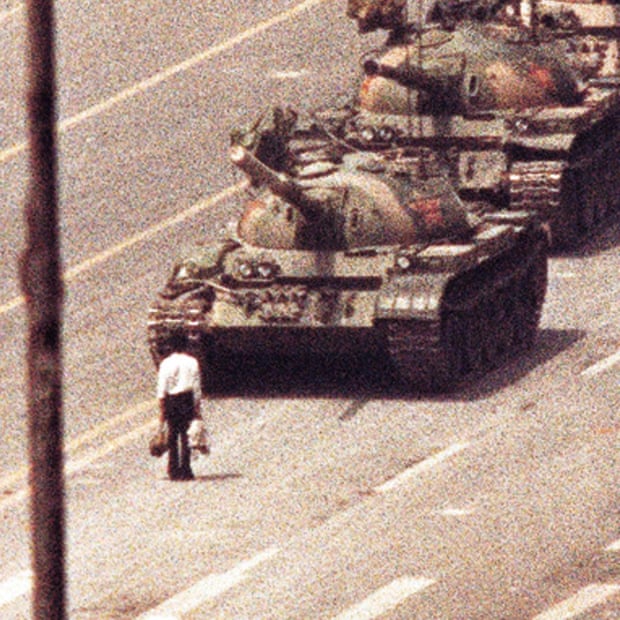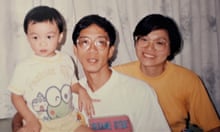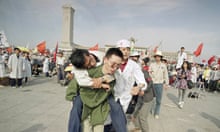Security forces have been deployed throughout Tiananmen Square in Beijing, 30 years on from a deadly crackdown on student demonstrators in the city that marked one of the darkest chapters in the country’s history.
Plainclothes and uniformed police patrolled the perimeter of the square, where crowds of tourists waited for security personnel to scan their ID cards. An armoured police car was stationed along a street leading to the square. Asked about the extra checks, a police officer said: “Today is a bit special.”
Foreign journalists were not allowed to enter the square and plainclothes police blocked reporters from taking photos by opening umbrellas in front of them. Major foreign news sites that had not been previously blocked in China, including CNN, could not be accessed on Tuesday.
On 3 June through the morning of 4 June 1989, the Chinese government deployed the military to put down almost two months of student-led protests that called for political reforms.
Tanks and troops converged on Tiananmen Square, shooting and in some cases crushing civilians. Estimates for the death toll range from a few hundred to 3,000. A secret UK diplomatic cable released in 2017 put the figure at at least 10,000.
Q&AWhat caused the 1989 protests in Tiananmen Square?
Show

In April 1989, popular Chinese reformist leader Hu Yaobang died. Two days after his death, on 17 April, several hundred students marched to Tiananmen Square and laid a wreath to him. They called for greater freedom of speech, economic freedoms and curbs on corruption. The demonstrations spread to hundreds of cities.
On 26 April, an editorial in the Communist Party’s People’s Daily denounced the student demonstrations as a ‘premeditated and organised conspiracy and turmoil’. The next day, tens of thousands of students in Beijing staged a demonstration to protest against the editorial. On 13 May, just two days before the arrival of Soviet leader, Mikhail Gorbachev for a state visit, hundreds of students began a hunger strike in Tiananmen Square. The protests forced the cancellation of the welcoming ceremony. On 20 May, martial law was declared in parts of Beijing. Troops moved in, but were blocked by the civilians and demonstrations continued.
In the early hours of 4 June, Chinese troops launched a two-pronged attack with orders to put down the protests. Armoured cars and tanks smashed through the citizens’ barricades. Some forty workers who went to plead with the soldiers were shot. On 5 June, an unidentified young man stood in front of a tank convoy leaving Tiananmen Square, in a final act of defiance. The actual number of deaths from the crackdown remains unknown, but it is believed the Chinese army killed at least 10,000 people, according to a secret diplomatic cable from the British ambassador to Beijing.
Thirty years on, the Chinese authorities continue to view the Tiananmen protests as one of the most sensitive and taboo subjects. ‘June 4’, as the movement is commonly known as in China, remains largely scrubbed from official history and is censored from school text books and online. The authorities punish those who try to commemorate the event, and relatives of the victims who died during the massacre are barred from openly mourning their loved ones.
Verna Yu in Hong Kong
China has issued few statements about the Tiananmen crackdown, which is largely omitted from history books. Official media on Tuesday made no mention of the anniversary, instead featuring articles about the Chinese leader Xi Jinping’s promotion of refuse sorting, an environmental campaign, and calls to “remember the mission” of the Chinese Communist party.

When pushed to comment, officials justify the government’s use of force as necessary for the country’s stability and economic development. China’s defence minister, Wei Fenghe, on Sunday defended the crackdown as the “correct” policy to end “political turbulence” at the time.
On Monday, the state-run tabloid Global Times praised the government’s response, calling it a “vaccination” for Chinese society, providing “immunity against any major political turmoil in the future”.
Before the anniversary, other countries called for China to acknowledge its use of violence against unarmed citizens. The US secretary of state, Mike Pompeo, said China must “make a full public accounting of those killed or missing”. China on Tuesday called those remarks “an affront to the Chinese people” and filled with “prejudice and arrogance”.
The EU foreign policy chief, Federica Mogherini, reiterated the European council’s statement from 1989, describing the government’s actions as a “brutal repression”. She called on authorities to respect the legal rights of those detained in connection with the 1989 protests as well as those who have tried to commemorate them.
Observers say the 1989 Tiananmen crackdown was a turning point for the country, marking the Chinese leadership’s bend towards authoritarianism. That spring, after years of increased openness, authorities were confronted with student movements in more than 300 cities, calling for reforms, an end to government corruption, a free press, and other demands.
After weeks of division within the senior leadership, conservative voices within the government won out, opting to use force to clear the centre of the movement, the protests in Tiananmen Square. Thousands were arrested after the crackdown and the government launched a propaganda drive to recast the episode as the successful “quelling of a counter-revolutionary rebellion”.
Since then, the party leadership has focused on expanding and opening its economy, while tightening the space available to civil society. After Xi came to power in 2012, Chinese activists and human rights advocates have come under even more pressure and censorship has increased.
In the lead-up to the 4 June anniversary, dozens of activists have been detained and censorship appears to have increased. Restrictions were placed on the “Tiananmen mothers”, a group of elderly women whose sons were killed. Many activists based in China are “travelled” outside of their cities and kept under close watch by minders.
On Tuesday, the search terms “Tiananmen” and “6,4,30” in reference to the 30-year anniversary, were blocked on the microblog Weibo. On WeChat, users could not change their usernames.

Activists in China said they planned to fast for the day, barred from being able to commemorate the event in any public way or with others. “Even though we are scattered … we are united and together,” said one of the organisers, based in China, who asked not to be named for security reasons.
Gao Yu, a journalist who attended the protests in Beijing in 1989, said she would be kept under close watch all day by security. “I can only remember [the students] in my heart,” she said.
In neighbouring Hong Kong, activists are commemorating the event with an annual candlelight vigil attracting about 180,000 people. “The whole of China is silenced, and we have a window, or a loudspeaker for that in Hong Kong, to tell the world what happened,” said Lee Cheuk-yan, a former legislator who was in Beijing at the time of the crackdown.
“I heard the gunshots, and saw the tanks rolling in, the rickshaws taking injured people,” said Lee, who was a labour organiser in 1989. “When I came back from Beijing 20 years ago, people told me to make sure you tell the world the truth.”
On Tuesday, activity around Tiananmen Square appeared normal. Tourists holding umbrellas to block the sun made their way to the main square. Groups of students followed their teachers in neat lines. Souvenir shops were open, selling memorial plates featuring Mao Zedong’s portrait.
Despite the censorship, some Chinese citizens found ways to mark the day, posting poems, images, or songs. One user posted a photo of himself standing in front of a Mao portrait, which faces Tiananmen Square, in the early morning hours. “Tomb sweeping,” he wrote, a reference to a Chinese tradition of honouring the dead.
Other users quoted part of a 1933 essay by a famous Chinese writer, Lu Xun, remembering a group of young writers and activists who had previously been killed by government forces.
Quoting Lu, they wrote: “The night is so long and the road so far; it might be better just to forget and not speak of them. But I know that even if I’m not the one, in the future, there will come a time when they will be remembered and spoken of again.”









